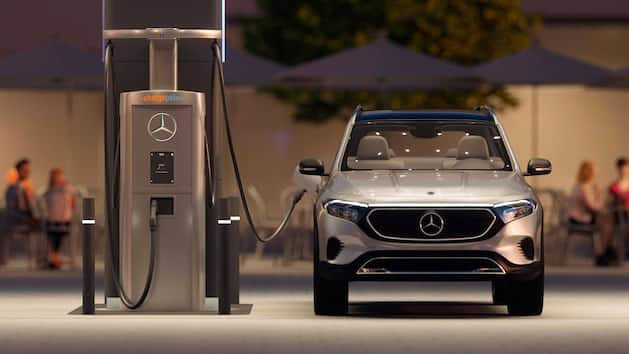It should be open to all vehicle brands, but only Mercedes customers can reserve a charging point. By the end of the decade, the HPC network should offer around 10,000 charging points worldwide.
The fast-charging hubs are to be set up in major cities near main thoroughfares and conveniently located shops. According to Mercedes, the first charging park will be built in North America in 2023. Europe, China and other core markets are to follow.
Depending on the region and location, the charging stations will offer four to twelve, but sometimes up to 30 high-power chargers with a charging capacity of up to 350 kW. Intelligent charging management is intended to ensure that each vehicle is operated with its maximum charging capacity. Loading should be possible from both sides and there should be plenty of free space around the vehicle. Where possible, the charging points will be covered.
Green electricity is charged. This is preferably ensured through green electricity supply contracts or certificates. Photovoltaics should also be used in part, but only for the needs of the station itself, i.e. for lighting, video surveillance and the like. When choosing a location, Mercedes wants to pay attention to nearby restaurants or cafes and toilets. For security reasons, the stations are equipped with surveillance cameras.
In North America, the network is expected to include more than 400 charging parks and over 2,500 fast chargers by 2027. The North American network is expected to cost around one billion euros. About half of the capital for this comes from Mercedes and the partner MN8 Energy, an operator of solar energy and battery storage systems. The second partner is a charging network operator: the company called ChargePoint is apparently supposed to help set up the stations.
You have to make sure that the charging network keeps up with the number of electric cars, said Mercedes boss Ola Källenius. “We don’t want to watch and wait for it to be built. That is why we are building a global fast charging network ourselves. It should become another distinguishing feature for owners of a Mercedes-Benz and an asset with value creation potential for our company. But that didn’t happen.
However, 10,000 charging points worldwide are no more than a drop in the ocean. For comparison: Tesla already has over 35,000 Superchargers worldwide. Even compared to the plans of the federal government – one million publicly accessible charging points by 2030 in Germany alone – 10,000 charging points worldwide will hardly be noticeable.
Källenius admits that; he was primarily concerned with the reservation options for Mercedes customers. He also references the million charging points available worldwide through the Digital Charging Solutions (DCS) network. This charging network was originally initiated by BMW; In addition to Mercedes, BMW and Mini, it is also used by Audi, Hyundai and Kia, among others.
This article was written by Stefan Leichsenring
Street dog Sammy was supposed to be handed over to his new owner at Munich Airport. But the six-month-old four-legged friend escaped. The search for him, which lasted more than a week, is now coming to a happy end.
In his autobiography “Spare” Prince Harry once again unpacks about his family. So far, as usual, she has been very silent. But public reluctance is deceptive. Position is taken in the background.
The original of this article “Mercedes announces its own fast-charging network” comes from InsideEVs.de.
On our e-mobility portal EFAHRER.com you will find all e-vehicles available on the German market
You can also arrange a test drive for the car of your choice free of charge and thus start e-mobility in an uncomplicated manner.















